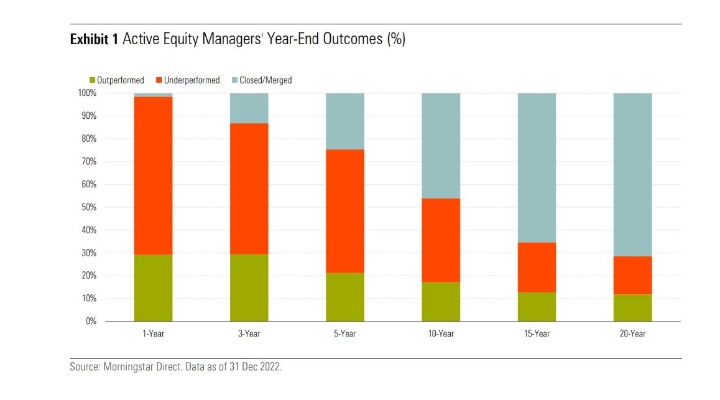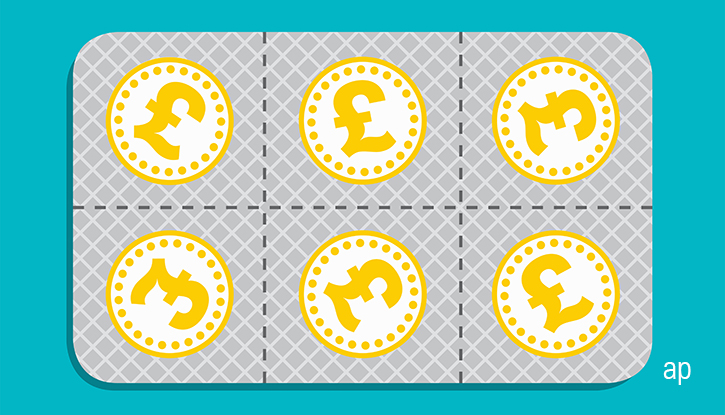
2022 presented active fund managers with the perfect opportunity to demonstrate their worth, but they largely failed to do so.
That is the conclusion of Morningstar’s 2023 European Active/Passive Barometer, its 10th such report on the state of play of nearly 26,000 unique active and passive funds across 2022, accounting for approximately €5.1 trillion (£4.5 trillion) in assets.
Conventional wisdom would have it that active management navigates down markets better than passive strategies. But speaking at the launch of the European iteration of the barometer report, Morningstar director of passive strategies Monika Dutt said active equity managers in particular had failed to show their worth (see Exhibit 1).
"Undoubtedly this was a very difficult market, in which the Morningstar global equity index and global bond index both declined by 17% during the 2022 calendar year," she said.
"This is the type of environment in which you would expect active managers to be able to outperform passive peers, but what we saw at year’s end was that only 29% of active equity managers were able to both survive and outperform their passive peers during the 2022 calendar year – so despite this unprecedented market environment, active managers in the active space were not able to produce an outcome that was superior to their index peers."
On average, 30.5% of active funds in the 43 equity categories we analysed survived and outperformed their passive peer in the one-year period to the end of December 2022. Only a mere three equity categories showed a rate of success for active managers at or above 50% in this period, the report says.
Managers in the fixed income space fared better, however. In a rising interest rate environment, active bond managers have been able to buy shorter duration securities to reduce rate risk. (Duration is the sensitivity of the price of a bond to interest rate changes.)
Passive funds tracking all-maturity indexes were at a clear disadvantage in that environment. The average rate of success for active fixed-income managers in the 23 categories we analysed stood at 46% in the 12 months ended December 2022. Nine categories showed a one-year success rate at or above 50%.

When it comes to fund flows, Morningstar director of fund research Jon Miller says the picture is "not pretty."
"Taking fund flows as a starting point, you've got to admit it's not pretty," he says.
"In 2022, if we look at our fund flows analysis (of UK-domiciled open-ended funds, including index trackers, but not ETFs or funds of funds) for 2022 shows there was £23 billion in net outflows from active." The bulk of that happened in the third quarter as the market sold off, he adds, and UK equities really felt the brunt of it."
Useful Measuring Stick
Morningstar regularly publishes performance data on active and passive performance, culminating in at least two annual reports – one for the US, and another on Europe.
The report itself evaluates active funds against a composite of actual passive funds – not versus a costless index. In this way, the benchmark reflects the actual, net-of-fee performance of the passive funds available to investors.
Active funds are assessed based on their beginning-of-period category to better simulate the funds an investor would have chosen at that time. The methodology also considers how the average unit of currency invested in different active funds has fared versus the average unit of currency in passive funds.
This week, the US iteration of the report showed that 43% of active funds in Morningstar’s analysis survived and outperformed their average passive peers in 2022. US stock pickers were among the best-performing, with a one-year success rate of 49% in 2022.
Dimitar Boyadzhiev, Morningstar senior manager research analyst for passive strategies, says investors can use the report as a measuring stick.
"The Active/Passive Barometer is a useful measuring stick that can help investors calibrate the odds of succeeding with active funds in different areas based on recent trends and longer-term history," he says.
"We include historical active funds' success rates in our analysis. This provides a valuable insight into how active managers have navigated market events in the past and how this affected their short- and long-term performance."




























